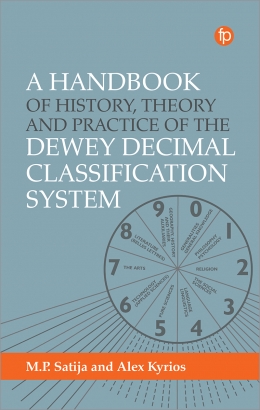
Primary tabs
You don't need to be an ALA Member to purchase from the ALA Store, but you'll be asked to create an online account/profile during checkout to proceed. This Web Account is for both Members and non-Members. Note that your ALA Member discount will be applied at the final step of the checkout process.
If you are Tax-Exempt, please verify that your account is currently set up as exempt before placing your order, as our new fulfillment center will need current documentation. Learn how to verify here.
- Description
- Table of Contents
- About the authors
- Reviews
This book will be an indispensable guide to 21st-century DDC, an essential companion for DDC classifiers, and accessible for students and continuing learners as well.
The Dewey Decimal Classification (DDC), used in 200,000 libraries across 140 countries, has entered a new age, primarily maintained today as a continuously revised electronic system rather than an occasionally updated set of print volumes. Its editors have added newly emerging topics and made it an increasingly faceted, semantically rich, modern system. Simultaneously, the editorial process has become democratised and more responsive to global needs. A Handbook of History, Theory and Practice of the Dewey Decimal Classification System is a comprehensive, practical guide to today's DDC. Coverage includes
- a brief history of the system, its editors, and its development;
- specialized examinations of specific parts of the classification;
- extensive guidance on number building, with many examples;
- a WebDewey-specific chapter, covering the system's benefits and features; and
- concise summaries of primary takeaways, a glossary, and extensive bibliography.
Chapter 1: A Brief History of the Dewey Decimal Classification
Chapter 2: Governance and Revision of the DDC
Chapter 3: Introduction to the Text
Chapter 4: Basic Plan and Structure
Chapter 5: Subject Analysis and Locating Class Numbers
Chapter 6: Tables and Rules for Precedence and Citation Order
Chapter 7: Number Building
Chapter 8: Use of Table 1 Standard Subdivisions
Chapter 9: Use of Table 2 Geographic Areas, Historical Periods, Biography
Chapter 10: Use of Table 4 Subdivisions of Individual Languages, and Table 6 Languages
Chapter 11: Use of Table 3 Subdivisions for the Arts, for Individual Literatures, for Specific Literary Forms
Chapter 12: Use of Table 5 Ethnic and National Groups
Chapter 13: Multiple Synthesis: Deeper Subject Analysis
Chapter 14: Classification of General Statistics, Law, Geology, Geography, and History
Chapter 15: Using the Relative Index
Chapter 16: WebDewey
Chapter 17: Options and Local Adaptations
Chapter 18: Current Developments in the DDC and Future Trends
Appendix 1 A Broad Chronology of the DDC, 18511-–2022
Appendix 2 History of Other Versions of the DDC
Appendix 3 Table of DDC Editors
Appendix 4 Editors of the DDC
Appendix 5 Takeaways
Further resources
M. P. Satija
M. P. Satija is an Emeritus fellow in the Department of Library & Information Science, Guru Nanak Dev University, India. In his long professional career he has written extensively on library classification systems, especially the Dewey Decimal Classification and the Colon Classification. He has authored textbooks on every edition of the DDC since the 19th (1979). He has collaborated with three successive editors of the DDC and his works have been translated in many European, and Asian languages. Dr. Satija serves on the editorial boards of many international journals including the ISKO journal Knowledge Organization, and is a member of the UDC Consortium, The Hague.
Alex Kyrios
Alex Kyrios is the Senior Editor of the Dewey Decimal Classification at OCLC, based out of the Library of Congress in Washington, DC USA. He is responsible for overseeing the continuous updating and revision of the classification, and works with partners and volunteers around the world to do so. Previously, he was a cataloguer at the Folger Shakespeare Library, Washington, D.C. and the University of Idaho. He has an M.S. in library science from the University of North Carolina at Chapel Hill, and a B.A. in English from the College of William & Mary, Williamsburg, Virginia.
Have you read this book? Leave a review!
"An essential volume for any library’s professional reference shelf— even if the library does not use the DDC as its main classification scheme. It also serves as a great instructional primer for newly-minted technical services librarians seeking succinct, easy-to-access information about how the DDC’s tables, charts, and indexes are arranged, governed, and function ... [It] has the potential to serve as the primary DDC handbook for years to come."
— Technicalities
Praise for the book
"Published 150 years after its conception by Melvil Dewey and written by two experts in the system, A Handbook of History, Theory and Practice of the Dewey Decimal Classification is the definitive guide to the DDC. Written in a practical manner, it explains DDC’s history, structure, how-to-use tables, and scopes up to the current WebDewey. What I find most noteworthy is the material on the history of the DDC, which is rarely found in other books, especially the introductions and biographies of past editors."
— Keiichi Fujikura, Chief Librarian, Bunkyo University Library, Japan


